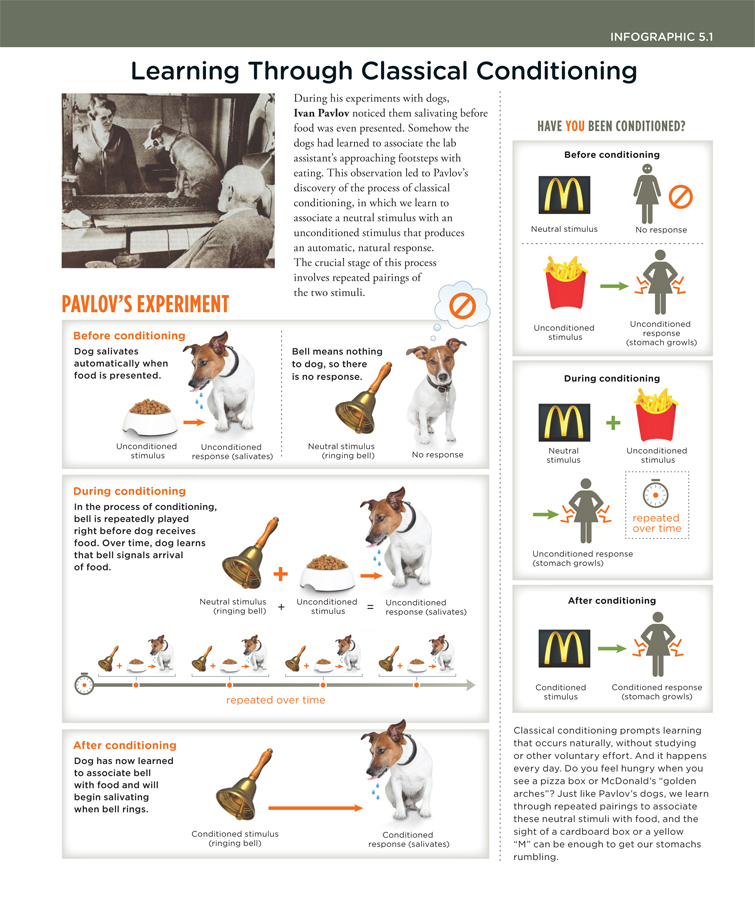Chapter 1. Learning Through Classical Conditioning
Infographic
Scientific American: Psychology
Infographic Activity 5.1: Learning Through Classical Conditioning
Learning Through Classical Conditioning

During his experiments with dogs, Ivan Pavlov noticed them salivating before food was even presented. Somehow the dogs had learned to associate the lab assistant’s approaching footsteps with eating. This observation led to Pavlov’s discovery of the process of classical conditioning, in which we learn to associate a neutral stimulus with an unconditioned stimulus that produces an automatic, natural response. The crucial stage of this process involves repeated pairings of the two stimuli.
Click the image to enlarge.
Click "Next" to continue.
1.1 Quiz
1. While driving down the road one day, you see your favorite doughnut shop in the shopping center. The “Hot Donuts” sign is illuminated, indicating that the donuts were just made, and you can detect just a hint of the scent of fresh sugary donuts in the air. You immediately begin to salivate, even though you were not really hungry before you saw the sign or smelled the donuts. This response is probably a result of
| A. |
| B. |
| C. |
| D. |
2. Which of the following statements is true regarding the process of classical conditioning?
| A. |
| B. |
| C. |
| D. |
3. Why was the ringing of a bell in Ivan Pavlov’s original experiment on learning termed a “neutral” stimulus?
| A. |
| B. |
| C. |
| D. |
4. Marcia grew up in an older house with outdated plumbing. As a result, whenever anyone took a shower people knew not to flush any toilet in the house, or else the person in the shower would get drenched with very hot water. Marcia suffered through this event many times growing up. Now she is a grown woman who lives in a modern house with updated plumbing, so this risk of getting burned in the shower is no longer a problem. Despite this change, she still tends to jump back anytime she is in the shower and she hears someone flush a toilet. Marcia’s tendency to jump when she hears the sound of a flushing toilet is an example of a(n) ________.
| A. |
| B. |
| C. |
| D. |
5. James is a new cat owner, and he does not know that it is very unusual to actually take his cat to the bathroom to give her a bath. He tends to whistle a lot around the home, and every time he picks up the cat and carries her to the bathroom he habitually whistles “Pop Goes the Weasel.” Lately he has noticed that whenever he whistles that same tune, the cat runs away from him even though he was not going to give her a bath. The song that James whistles has become a(n) ________ for his cat.
| A. |
| B. |
| C. |
| D. |
6. Crystal is resting in her hospital bed, exhausted but ecstatic. She is holding her newborn baby who is only a few hours old. She is singing a lullaby to the baby, but she notices that every time she sings a little louder the baby blinks a few times. Eventually she realizes that she is blowing in the baby’s eyes while she sings, and that this is why the baby is blinking. In this example, the baby’s blink is an example of a(n) ________.
| A. |
| B. |
| C. |
| D. |
7. Jonathan is 12 years old, and he enjoys playing a mean little game with his brother Liam, who is only 10. Every time Jonathan sees a specific type of car driving down the street, he yells, “Punchbug,” and punches Liam in the arm. Even though he doesn’t punch him hard, Liam complains that it hurts and tells him to stop. Jonathan does not stop, however, and does it several more times before his mother intercedes. The next time they family passes this specific car, Liam jumps even though Jonathan doesn’t say anything or move to punch his arm. In this example, the pain of being punched has acted as a(n)
| A. |
| B. |
| C. |
| D. |
Activity results are being submitted...